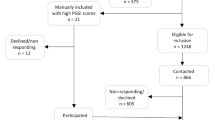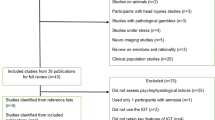Abstract
Aims. To examine changes in skin conductance level (SCL), for problem gamblers in response to personally relevant imaginal tasks, representing winning or losing. Setting, design, participants and measurements. SCL and subjective arousal were compared for problem poker machine gamblers (n = 13) and a control group (n = 20). Participants were asked to describe a situation in which they had (a) won and (b) lost during a period of gambling. Before and during the task, recordings of SCL were taken. Findings. There were significant differences between responses of problem and social gamblers. A significant interaction indicated that social gamblers became more aroused in reaction to winning than losing, whereas problem gamblers became equally aroused in response to both tasks. Conclusions. The results suggest that it may be responses to losing, rather than winning that are paramount to the development and maintenance of problem gambling.
Similar content being viewed by others
References
American Psychiatric Association (1987). Diagnostic and Statistical Manual of Mental Disorders-III-R (Washington: APA).
American Psychiatric Association (1994). Diagnostic and Statistical Manual of Mental Disorders-IV (Washington: APA).
Anderson, G. & Brown, R.I. (1984). Real and laboratory gambling, sensation seeking and arousal. British Journal of Psychology, 75, 401-410.
Blaszczynski, A. & Nower, L. (2002). A pathways model of problem and pathological gambling. Addiction, 97, 487-499.
Blaszczynski, A.P., Wilson, A.C. & McConaghy, N. (1986). Sensation seeking and pathological gambling. British Journal of Addictions, 81, 113-117.
Brown, R.I.F. (1986). Arousal and sensation seeking components in the general explanation of gambling and gambling addictions, International Journal of Addictions, 21, 1001-1016.
Coloumbe, A, Ladouceur, R, Deshairnais, R. & Jobin, J. (1992). Erroneous perceptions and arousal among regular and irregular video poker players, Journal of Gambling Studies, 8, 235-244.
Coventry, K.R. & Constable, B. (1999). Physiological arousal and sensation-seeking in female fruit machine gamblers. Addictions, 94, 425-430.
Coventry, K. R. & Norman, A.C. (1997). Arousal, sensation seeking and frequency of gambling in off-course horse race bettors. British Journal of Psychology, 88, 671-681.
Coventry, K. R. & Norman, A.C. (1998). Arousal, erroneous verbalizations and the illusion of control during a computer-generated gambling task. British Journal of Psychology, 89, 629-645.
Dickerson, M. (1993).Internal and external determinants of persistent gambling: Problems in generalising from one form of gambling to another, Journal of Gambling Studies, 9, 225-245.
Griffiths, M. (1991). The psychobiology of the near miss in fruit machine gambling, The Journal of Psychology, 125, 347-358.
Griffiths, M. (1999). The psychology of the near-miss (revisited): A comment on Delfabbro and Winefield (1999), British Journal of Psychology, 90, 441-446.
Ladouceur, R., Jacques, C., Ferland, F. & Giroux, I. (1999). Prevalence of problem gambling: A replication study 7 years later. Canadian Journal of Psychiatry, 44, 802-804.
Leary, K. & Dickerson, M. (1985). Levels of arousal in high-and low-frequency gamblers. Behaviour, Research and Therapy, 10, 111-117.
Leopard, D. (1978). Risk preference in consecutive gambling, Journal of Experimental Psychology: Human Perception and Performance, 4, 521-528.
Lesieur, H.R. & Blume, S.B. (1987). The South Oaks Gambling Screen (SOGS); a new instrument for identification of pathological gamblers, American Journal of Psychiatry, 144, 1184-1188.
McConaghy, N. (1980). Behavioural completion mechanisms rather than primary drives maintain behavioural patterns, Activas Nervosa Superior (Praha), 22, 138-151.
McKnight, M., Warrington, B. & Hamel, M. (1992). Chart (v3.2): User Manual. (Australia, AD instruments).
Sharpe, L. (2002). A reformulated cognitive-behavioural model of problem gambling: A biopsychosocial perspective. Clinical Psychology Review, 22, 1-25.
Sharpe, L. & Tarrier, N. (1993). Towards a cognitive-behavioural model of problem gambling behaviour, British Journal of Psychiatry, 162, 407-412.
Sharpe, L., Tarrier, N., Schotte, D. & Spence, S.H. (1995). The role of autonomic arousal in problem gambling. Addiction, 90, 1529-1540.
Spielberger, C.D., Gorusch, R.L., Luschene, R.E., Vollberg, P.R. & Jacobs, G.A. (1986). Manual for the State-trait Anxiety Inventory (Self-evaluation Questionnaire), (Palo Alto, Consulting Psychologists Press).
Author information
Authors and Affiliations
Corresponding author
Rights and permissions
About this article
Cite this article
Sharpe, L. Patterns of Autonomic Arousal in Imaginal Situations of Winning and Losing in Problem Gambling. J Gambl Stud 20, 95–104 (2004). https://doi.org/10.1023/B:JOGS.0000016706.96540.43
Issue Date:
DOI: https://doi.org/10.1023/B:JOGS.0000016706.96540.43




